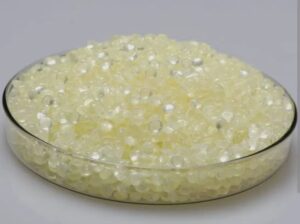C9 Hydrocarbon Petroleum Resin
Product Description
C9 Hydrocarbon Petroleum Resin is a thermoplastic resin derived from the polymerization of C9 aromatic hydrocarbons. It is characterized by its excellent compatibility with various polymers, low viscosity, and high softening point. This resin is primarily used as a tackifier in adhesives, sealants, coatings, and inks, enhancing their performance and durability. Its chemical structure allows for a wide range of applications, making it a versatile component in many industrial formulations.
Uses
C9 Hydrocarbon Petroleum Resin is utilized in various industries due to its unique properties. Some of the primary applications include:
- Adhesives: Enhances tackiness and bonding strength in hot melt and pressure-sensitive adhesives.
- Coatings: Improves gloss, hardness, and chemical resistance in paints and coatings.
- Inks: Used in printing inks to enhance adhesion and drying properties.
- Sealants: Provides flexibility and durability in construction and automotive sealants.
- Rubber Compounding: Acts as a processing aid and improves the performance of rubber products.
Technical Data
| Property | Value |
|---|---|
| Appearance | Yellow to amber solid |
| Softening Point (°C) | 90 – 120 |
| Density (g/cm³) | 1.05 – 1.10 |
| Viscosity (cP at 200°C) | 100 – 300 |
| Molecular Weight | 1000 – 3000 |
| Glass Transition Temperature (°C) | -20 to -10 |
| Compatibility | Compatible with various polymers, including EVA, SBR, and natural rubber |
| Solubility | Soluble in aromatic and aliphatic hydrocarbons, insoluble in water |
Key Features
- High Softening Point: Provides thermal stability in high-temperature applications.
- Excellent Adhesion: Enhances the bonding properties of adhesives and sealants.
- Versatile Compatibility: Works well with a variety of polymers and resins.
- Low Viscosity: Facilitates easy processing and application in formulations.
Conclusion
C9 Hydrocarbon Petroleum Resin is a crucial ingredient in many industrial applications, offering enhanced performance characteristics. Its versatility and compatibility with various materials make it an essential component in the production of adhesives, coatings, inks, and sealants.

